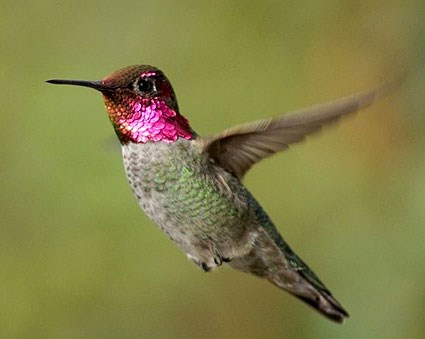Hummingbird Vocal Learning
Biology 342 Fall 2015
Alex Loukides and Hannah McConnell
Auditory learning is the ability to make sound associations and is present in all vertebrates. Vocal learning is the ability for an animal to imitate sounds that it hears. In most avian vocal learners, song develops during a critical period in adolescence, during which a juvenile must be able to hear correct examples of adult song, and hear and self-modify its own song. After this critical period, for most birds, hearing new songs will not affect their own vocalizations, and they do not create or learn different songs that what they already sing.
Vocal learning is known in three different avian orders: Passeriformes, perching birds or songbirds; Psittaciformes, parrots; and Trochiliformes, hummingbirds. Unusual among vocal learners, hummingbirds continue to alter their songs and learn new song repertoires over time. This occurs in hummingbirds at a variety of ages, long after the critical period has closed. Most other birds retain the same song throughout their lives, without acquiring new repertoires. In this way, vocal learning among hummingbirds is particularly unique, as they are able to continue learning songs after the juvenile sensitive period.
This website will attempt to utilize the four questions detailed in Tinburgen's 1964 paper that outlines the following categories of classification of investigation of animal behaviors: Phylogeny, Ontogeny, Mechanism and Adaptive Value. In each, a different aspect of hummingbird vocalization is discussed. Phylogeny of the vocalization of hummingbirds involves the evolution of their vocalization, while Ontogeny investigates the developement of the behavior over a hummingbird's lifetime. Adaptive Value discusses how hummingbird vocalization is used to increase their lifetime reproductive fitness, and Mechanism details the physiological aspects of how vocalization occurs.

Figure 1: Anna's Hummingbird in midflight
Pacific Southwest Region USFWS. "Anna's Hummingbird."
Flickr. Yahoo!, Web. 23 Oct. 2015.